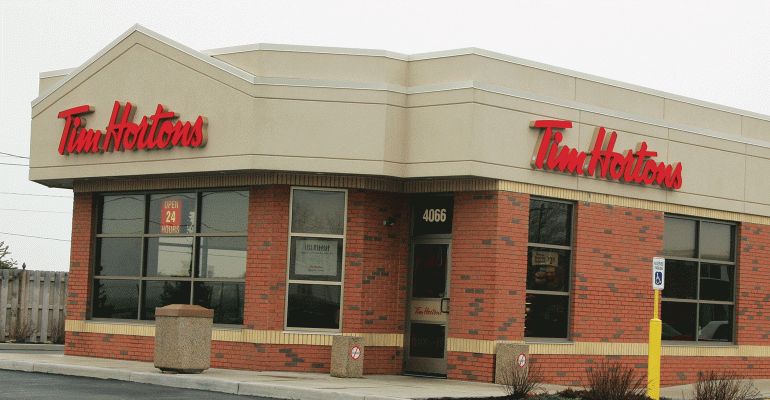Despite a decrease in same-store sales at two of its three restaurant concepts, Restaurant Brands International reported a net income of $626.1 million for the fiscal and calendar year 2017, or $2.54 per share, up from $345.6 million, or $1.45 per share, in 2016, thanks to robust growth in restaurant openings and the acquisition of Popeyes Louisiana Kitchen in March.
Same-store sales at Tim Hortons were down 0.1 percent for the year and at Popeyes they were down 1.5 percent. However, the largest brand, Burger King, saw comp sales growth of 3.1 percent.
“We are pleased to report another year of strong results,” CEO Daniel Schwartz said in a release announcing the results.
“After acquiring Popeyes earlier in 2017, we made good progress integrating the business, and we remain highly encouraged by the brand’s growth potential. We also improved system-wide sales growth at Burger King this year, driven by accelerated net restaurant growth and continued comparable sales momentum.
All three brands saw improvement in the fourth quarter, with same-store sales at Tim Hortons up 0.1 percent, Burger King up 4.6 percent and Popeyes down 1.3 percent.
Net income for the quarter was $395 million, or $1.59 per share, up from $118.4 million or 50 cents per share in the fourth quarter of 2016.
In a conference call announcing the results, executives at the company, based in Oakville, Ontario, said they saw potential for all three brands to continue to grow internationally.
Burger King had a particularly good year with systemwide sales growth of 10.1 percent, thanks to net growth in number of restaurants by 6.5 percent. Total earnings before interest, taxes, depreciation and amortization (EBITDA) were $903 million for the year ended Dec. 31, 2017 — a 10.6 percent increase over the previous year.
Schwartz said that performance was aided by culinary innovation around the Bacon King and crispy chicken sandwiches, which performed particularly well, as well as value promotions.
“We believe that maintaining this balanced menu offering to provide our guests with products that they love at great prices will continue to drive further sales growth in the long run,” he said.
He also praised the chain’s creative and “edgy” marketing.
“Headlines that these campaigns generated helped to successfully drive comparable sales,” he said.
Among recent campaigns, was one around the launch of the Double Quarter Pound King — a clear imitation of McDonald’s Double Quarter Pounder with Cheese — highlighting the chain’s flame grilling compared to the flattop griddling at rival McDonald’s. One commercial offered condolences to flattop double quarter pound burgers. In another, Burger King’s mascot, The King, presented McDonald’s with the gift of a flame grill, highlighting the differences between the two brands.
Schwartz added that strength in many of the chain’s large international markets, including China, Turkey, Spain, Brazil, the United Kingdom and Russia, were “partially offset” by soft sales in Australia and South Korea.
Highlights at Tim Hortons over the year included the introduction of espresso, as well as new breakfast and baked goods, including a breakfast steak sandwich, a Simply Sausage offer and fall harvest and holiday offerings of muffins, doughnuts and “Tim Bits” or doughnut holes. The chain also launched its mobile app.
“The digital channel has been and will continue to be a key focus of ours as we continue to build the Tim’s brand,” Schwartz said.
In the fourth quarter, Tim Hortons launched lunch items to help shore up weakened performance during that daypart, including an artisan grilled cheese sandwich. In the first quarter of this year it introduced a turkey bacon club sandwich.
Schwartz said that in 2018 the chain would focus on its “coffee leadership,” as well as growing lunch and digital activity.
Popeyes saw systemwide sales up by 5.1 percent, driven by a net increase of 6.1 percent in the number of restaurants. The chain had difficulties in the United States, where same-store sales were down 2.2 percent, compared to 1.5 percent globally, due to value discounting from competitors.
“We continue to be quite encouraged by the outlook for the Popeyes business as the pace of development has accelerated this most recent year and unit economics continue to be quite strong,” Schwartz said.
He said Popeyes had particular potential globally, where its food enjoyed broad appeal.
In the fourth quarter the chain opened its first restaurant in South Africa, which Schwartz said was “a natural market for the brand, given the fit of our Louisiana style flavor profile with local tastes.”
He added that international growth would be a priority for Popeyes in 2018.
“The thing that maybe got us the most excited about Popeyes from the beginning was the ability to grow the brand all around the world, in so many of these global markets,” he said, adding that the company would work on developing global relationships with potential franchisees.
Total revenue for the year was $4.6 billion, up from $4.2 billion in 2016.
For the fourth quarter, revenue was $1.2 billion, up from $1.1 billion in 2016.
Contact Bret Thorn at [email protected]
Follow him on Twitter: @foodwriterdiary





